Marketing has moved on. People trying to market a software-as-a-service (SaaS) product know that and feel that pain on a regular basis – too many options, strategies and tactics, extreme market saturation, and more. And it keeps changing at a crazy rapid pace.
The same things that make SaaS marketing extremely hard also make it just as interesting – it’s impossible to get any traction in the SaaS world without being both creative and strategic. In this guide, we’re focusing on the strategy part. We’ll describe 12 SaaS marketing strategies with their pros and cons – and leave it up to you to be creative about executing them.
What Makes SaaS Marketing Different
For a marketer coming from other verticals (sometimes called traditional marketing), SaaS marketing might be hard to adapt to because it’s quite different from what, for example, consumer goods marketers are used to. So, why is that the case, and what exactly makes it different?
Retention is Everything
Remember the popular saying that acquiring a new customer is ten times more expensive than keeping an existing customer? Yes, the one you’ve heard in “The Office” series. According to the Harvard Business Review, it’s actually from 5x to 25x (so, Ryan was quite right).
Retaining customers is even more important if you operate on a subscription basis, as the majority of SaaS businesses do. The longer you retain a client, the higher their lifetime value (CLV) becomes. Also, happy customers spread positive word-of-mouth.
Many other industries care much more about acquiring customers – a one-time sale is good enough for them. Converting first-time customers into returning ones is a nice bonus for traditional marketing. For a SaaS, acquisition is just a start, and retention is what matters most. That’s why retention is one of the most important SaaS marketing strategies, and it heavily influences others – like email marketing, for example.
Giving Away Free Stuff Works Like Magic
From free templates to free tools, and from free trials to free plans – giving away valuable things at no cost works wonders in SaaS marketing.
The idea is to provide some value for the prospects and – once they get a taste and start to recognize you – show them that paying for the service unlocks even more value. This way you get some of them to subscribe.
The free stuff isn’t always just a bait. Sometimes it’s a product of a genuine desire to help people, building a human and helpful brand, with hopes that being nice to people pays back.
There is something similar in traditional marketing, with Sephora giving you a bunch of small samples with every purchase. But it isn’t used at such a scale as in SaaS marketing.
Competing With Companies That Are Not Your Competitors
Ads and organic search are among the most widely used customer acquisition strategies for SaaS (we’ll get to them in a bit). Almost everyone uses them – and as a result, the market saturation is so high that the competition around certain keywords goes to extremes.
Often, SaaS companies try to bid on keywords that are relevant to the persona that they cater to, and as a result, they end up competing with other SaaS businesses that are trying to sell completely different products to the same persona.
To give you an example, Mouseflow, a SaaS behavior analytics platform, often finds itself competing for positions on Google search result pages (SERPs) with Hubspot, a CRM platform. As products, Mouseflow and Hubspot are by no means competitors – they compliment each other (we even have an integration). But they compete for the attention of the same group of people, so the keywords are often overlapping.
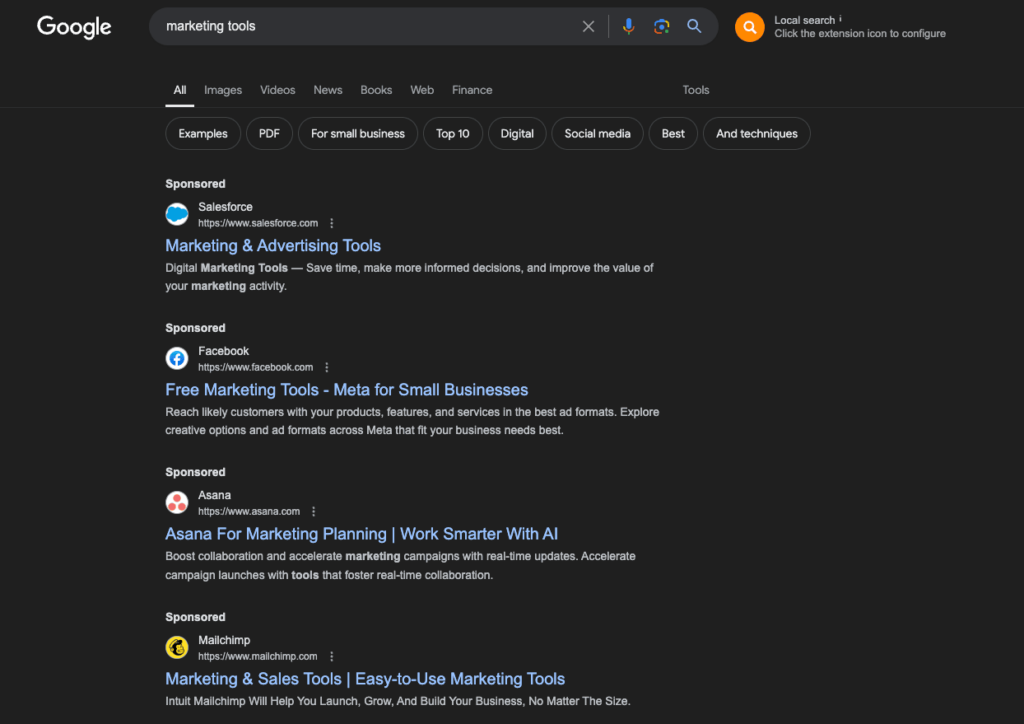
Salesforce, Facebook, Asana, and Mailchimp offer completely different products. Yet, they compete for the space at the top of the SERP for “marketing tools”
Long Sales Cycles and Uncertain Attribution
One of the many challenges of B2B SaaS marketing is long sales cycles. According to Dock, for products with annual contract value (ACV) of $5,000 or less, a sale takes about 40 days on average. When ACV goes over $100,000, the sales cycle becomes more than four times as long – about 170 days on average. In traditional marketing, even in B2B, it is rarely this long.
During the sales cycle, a potential customer has numerous touchpoints with the SaaS product company. In their research, HockeyStack found that for an ACV of $20,000 or less the average number of required touchpoints to close the deal is 31. But when ACV goes above $60,000, the required number of touchpoints rises to 75.
Which touchpoint do you attribute the conversion to? It certainly wasn’t only the first one, and it’s next to impossible to track all the touchpoints that a potential customer has with your company. So, attribution is another major problem in the world of B2B SaaS marketing. Especially now, when privacy laws are really strict and cross-platform tracking isn’t as efficient as it used to be.
The Service Matters as Much as The Product
The “service” part of “software-as-a-service” plays a huge role in retaining customers. That’s why SaaS companies invented customer success back in 1996 and keep competing with each other in terms of who offers better support.
Everyone tries to delight existing customers so that they feel well-cared for and important – and stay for longer, increasing retention and CLV. That, again, is not typical for companies that sell products on a one-time-purchase basis.
All of these differences can make SaaS marketing challenging. But if you know the SaaS marketing strategies that you can use well enough and choose them wisely for your SaaS go-to-market strategy, you are very likely to succeed (if your execution is as good as your planning). So, let’s discuss what these strategies can possibly look like.
12 Proven SaaS Marketing Strategies
- Content Marketing
- SEO & AI optimization
- Pay-Per-Click (PPC) Ads
- Social Ads and Retargeting
- Email Marketing
- Founder-led Marketing
- Influencer Marketing and Affiliate Marketing
- SaaS Comparison Websites
- Account-Based Marketing (ABM)
- Partnerships and Integrations
- Event Marketing
- Conversion Rate Optimization (CRO)
- Bonus: Churn Reduction
1. Content Marketing
Benefits:
- All other marketing strategies rely on content, at least to some extent.
- Allows you to build a unique brand and stay top-of-mind for huge audiences.
Risks:
- Requires plenty of effort to create high-quality, memorable content.
Content is king (and the source of touchpoints), so SaaS content marketing is perhaps the most common SaaS marketing strategy. It’s worth noting that content marketing is much more than just writing blogs for SEO purposes, even though SEO is still a huge part of it.
Content marketing strategies also include:
- Social media marketing. SaaS vendors are creating tons of content to engage people on different social media platforms – from LinkedIn to Facebook, from Instagram to TikTok, and from X (it’s so hard not to call it Twitter) to Reddit. Most of this content is visual – from static images to videos and carousels that have become extremely popular on LinkedIn.
- Video. More and more people consume more and more video content. Even though Youtube’s growth slowed down in 2022, it’s still growing. It has as many as 2.7 billion users in 2024. Many just don’t read anymore, at all. They only consume videos, so making video content is the only content marketing tactic that helps reach them.
- Podcasts. This format also keeps growing, with half a billion people listening to podcasts in 2024. Many podcasts are business-oriented, featuring experienced business executives discussing problems that many executives in the same industry face regularly. For SaaS companies, being featured on a podcast that their ideal customers regularly listen to is one of the fastest ways to win new deals. Many B2B SaaS vendors also launch their own podcasts. Take Shopify and their very popular Shopify Masters as an example.
- Webinars. Some say they are boring, but people still go to webinars to upskill and learn new things. And SaaS companies running a webinar get a chance to advertise their tools to those who signed up. Best of all, when people sign up for a webinar, they provide you with their contact information and, usually, consent to receive marketing communications. This allows you to send them emails afterward.
- Social advocacy. When a brand says something, people can be skeptical of it. However, when a person says something similar, but in their own words, their followers tend to put much more value into these words. That’s why many SaaS brands encourage employees to post on social media, and there are even special SaaS services that simplify that process – they’re called social media employee advocacy platforms.
And there are other content formats – from checklists and ebooks to memes and quizzes. Your content marketing strategy can include some combination; just don’t try to be everywhere at once. For any smaller SaaS brand, It’s better to have a few channels that you pay attention to and that really work, rather than plenty of half-abandoned and poorly performing ones.
The goal of content marketing isn’t necessarily to sell directly. For a B2B SaaS business, content marketing serves a lot of other purposes – from educating people to creating brand awareness and just staying on top-of-mind, creating these touchpoints desperately needed to close deals.
2. SEO & AI optimization
Benefits:
- If executed correctly, it allows you to build an acquisition channel with low customer acquisition cost (CAC) that scales better than the rest.
Risks:
- Takes a long time to execute and doesn’t bring immediate results.
- Is not very predictable due to algorithm changes.
Some say that search engine optimization (SEO) is a part of the content marketing strategy. Others think that it deserves a separate place in the list. Either way, we certainly can’t avoid talking about SEO as a SaaS marketing strategy. It’s a staple.
As a SaaS marketer, every now and then you’ll hear that “SEO is dead,” but that’s not really true. SEO has evolved a lot and is now more focused on providing value to the user rather than trying to somehow trick the search engines into showing a bad article at the top of the search results page.
Modern SEO strategy mostly relies on:
- offering experience and expertise,
- matching the search intent,
- providing a unique angle and helpful multimedia content,
- regularly updating content,
- and otherwise making sure that the website visitor gets what they are looking for (and you get more leads and sign-ups as a result).
Lately, a lot of users have stopped searching in Google and switched to AI platforms like ChatGPT or Claude. But AI still needs to get the information from somewhere (and it’s basically Google or Bing search), so for many SaaS businesses their SEO strategy now includes AI optimization (sometimes called GEO – Generate Engine Optimization). It boils down to making sure that large language models (LLMs) can find and access your content and list your ideas in their replies to people’s prompts.
Another modern SEO trend is paying more attention to website user experience – adding quality illustrations, removing friction points, and working on user paths to make them clearer.
If you want to lear more about how SEO and UX work, check out this blog post on improving content readability.
3. Pay-per-click (PPC) Ads
Benefits:
- Possible to get results in a very short amount of time.
- Allows to target audiences at the consideration stage.
Risks:
- Expensive.
- Doesn’t scale well.
For younger brands, SEO could be a very difficult game to play, as there are two ranking factors that take a lot of time to get right. One is topical authority – the amount of content you have on the topic. The other is domain authority – the amount of relevant backlinks a domain has accumulated over time. Gaining a significant domain authority takes years of hard work, but there’s always a shortcut for ending up at the top of the SERP – just pay for it.
Pay-per-click ads – Google Ads, Bing Ads, and the like – are another strategy that many SaaS marketers use. And not only for small brands – apparently, being at the top pays back so well that giant corporations don’t hesitate to bid their money on keywords.
A huge argument in favor of running Google Ads (or Bing Ads, or any other search ads) is the ability to occupy more space on the first SERP. If you have an organically ranking article – great. If, in addition to that, you run ads for the same keyword, you occupy twice as much space. That increases the likelihood of searchers ending up on your website.
For SaaS, great PPC tactics are:
- bidding on bottom-of-the-funnel keywords (“[your category] best tools”, “[your category] vendors”, and the like)
- bidding on competitors’ keywords (but you need to be clever about it.)
- retargeting and remarketing.
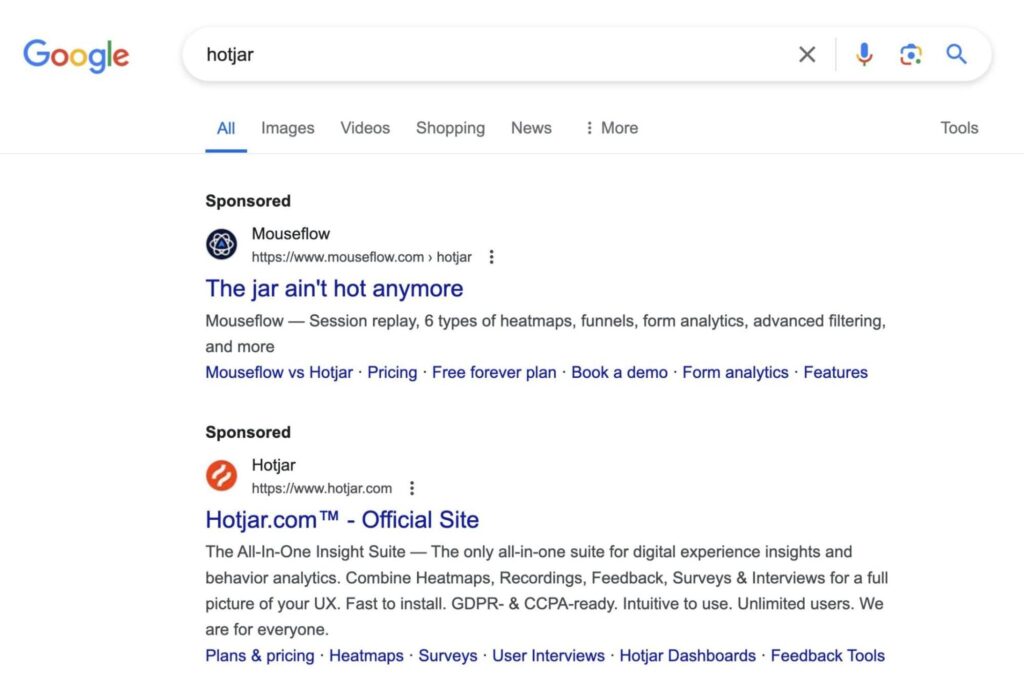
Our own example of bidding on a competitor’s keyword.
Google Ads keywords are also a great inspiration for SEO – the most converting keywords could be the ones that you should explore for creating organic content, so that you can get another piece of this pie and generate more leads for your SaaS.
5. Email Marketing
Benefits:
- No cost, aside from what you pay for the email marketing tool.
- The best strategy for nurturing both existing customers and prospects.
Risks:
- Overdoing email marketing annoys users instead of nurturing them.
Another strategy that is closely related to content marketing, email marketing is a tool used by every SaaS company.
There are two main parts to it – newsletters and email marketing automation. It’s hard to say which one of the two is more important than the other.
Newsletters are great for creating additional touchpoints for prospects and engaging existing customers.
As we’ve discussed earlier, in B2B SaaS marketing, sales cycles are usually very long and require not just several, but sometimes hundreds of touchpoints. Having a prospect subscribe to a newsletter is a major win for a B2B SaaS, as you get to control the touchpoints and create as many as needed – for free.
Like with the rest of content marketing, newsletters need to be interesting and helpful for the reader. Their purpose is not to sell, but to re-engage and help build a brand. A few years ago, you could send newsletters only via email, but recently, LinkedIn also began offering an option to run newsletters right on the platform.
Marketing automation works almost the same, but is, well, automated. After a website visitor signs up for a free tier of a SaaS product or performs a certain action, like attending a webinar, they receive a cadence of emails that guide them towards the desired action, such as subscribing to a paid plan.
6. Founder-led Marketing
Benefits:
- Low-cost, high-gain strategy if executed correctly.
Risks:
- Doesn’t work equally well for all founders.
- Takes founders’ time, which they usually lack.
- This strategy can turn against the business if the founder and the company part ways unamicably.
Founder-led marketing (also called founder marketing) is an emerging trend that isn’t new per se – some founders have been doing this for ages. But it’s been getting more traction lately as people experience marketing overload and continue to turn from companies to people.
A charismatic founder that knows their buyer personas well can run their own content marketing channels, such as a personal LinkedIn, podcast, or newsletter. There, they can speak about their experience and expertise, focusing not on the product, but on thought leadership instead. People prefer buying from people they trust, so having an influential founder could be a great asset in marketing a SaaS product.
A textbook example of founder-led marketing is Elon Musk and all his companies: any new product that he launches or endorses gets a lot of attention just because of the influence that he has. Richard Branson, the founder of Virgin, is another good example. However, not everybody can become the next Musk or Branson (which isn’t a bad thing).
Basically, a successful founder-led SaaS marketing strategy requires a very special type of founder. But where do you, as a SaaS marketer (and not a founder), come in? What you can do is try to empower the founder to post content regularly and help them engage with their audience: create content for them, track analytics, spread their content to other channels, and more.
7. Influencer Marketing and Affiliate Marketing
Benefits:
- High level of impact.
Risks:
- Can be expensive.
- Low control over the outcomes.
Third-party experts can market a product just as well as founders – they have their own audiences that trust them much more than any corporate communications. Word-of-mouth and recommendations from trusted experts sell like nothing else.
Some of these experts don’t mind endorsing the products they like – for a price. Sometimes, you can just sponsor their content creation – for example, get a placement in a podcast or a YouTube video series.
All of that requires building relationships with those influencers – or hiring an agency that will do that for you. The influencers need to know you and trust you enough to endorse your products, even on a sponsorship basis.
Also, influencer marketing poses some reputational risks if it goes wrong. An influencer can accidentally say something that doesn’t align with your brand at all, or they may end up in the middle of some scandal – and your SaaS brand could be dragged into this scandal together with them.
However, as long as you’re carefully choosing the influencers that you’re working with and taking time to align with them on each activation, influencer marketing is one of the best SaaS marketing strategies to try out.
Another model of working with influencers is referral marketing – when they get a share from each sale that they helped facilitate. Usually, referrals are a part of a more comprehensive influencer marketing strategy that also includes sponsorships.
8. SaaS Comparison Websites
Benefits:
- Increasing exposure and adding new customer acquisition channels, often at low or no cost
Risks:
- If you don’t have a great SaaS product or great support, you risk getting a stain on your reputation that is impossible to hide.
- Requires a long-time commitment.
When your potential customers are choosing a SaaS solution, they often compare several competing options. Your other marketing activities help you get onto their shortlist, but then they often rely on peer reviews to make a decision. And for that, they use comparison websites like G2, Capterra, Gartner, Sourceforge, and similar sites.
They are looking for detailed descriptions, feature comparisons, and reviews. So, your strategy is to make sure you:
- Are listed on these sites.
- Encourage your existing customers to leave reviews.
- Pay attention to what these reviews say, and try to solve all problems and address all complaints that your customers have.
That helps potential customers understand that you are real, that you listen to feedback, and that you keep improving your product (by the way, we have a post on the role of feedback in the SaaS development cycle). And that increases the likelihood of them choosing your solution.
Product Hunt
While it’s not a comparison website, we’d add it to the same category. A successful launch of a SaaS product on Product Hunt can bring plenty of attention to it, and not only from customers, but also from investors.
The latter means more investment money or even a potential exit (as a SaaS marketer with more than 8 years of experience, I’ve seen very few SaaS startups that don’t dream about an exit).
Product Hunt is more about launching than about maintaining a presence. But the B2B SaaS market is extremely saturated, so the amount of effort that goes into a launch that has a chance of being noticed can be tremendous. So, a Product Hunt launch can be a great SaaS marketing strategy, but not an easy one – and with quite a chance to flop and not be noticed at all.
9. Account-Based Marketing (ABM)
Benefits:
- A proven way to win enterprise customers, with each adding a nice bump to your ARR.
Risks:
- Very difficult to scale.
- Very resource-intensive.
If your SaaS product costs more than a few thousand dollars per year, account-based marketing is for you. Instead of waiting for people to come to you, you go to them. And of course, you don’t knock on every door – first, you choose the right accounts and try to get their contact information.
You can either choose to “spray and pray” with bigger databases or develop a more targeted and personalized approach with a smaller contact base – that’s up to you (and depends on the quality of the contact data you’ve managed to get). Either way, you’ll need a contact base from some source – either from tools with contact data like Zoominfo, Apollo, and Cognism or from platforms like the aforementioned G2 that can offer you buyer intent data.
In the end, ABM is always about quality rather than quantity. Even if you’re starting with a big and less targeted database, sales will end up working with only a few accounts from this database that were responsive to your targeted communications. By the way, ABM is a strategy that requires perfect alignment between sales and marketing, and a feedback loop between them that works both ways.
10. Partnerships and Integrations
Benefits:
- Highly scalable, can become one of the main acquisition channels.
- Long-term partnerships keep bringing new customers with little effort from your side.
- Integrations can boost your product functionality and make it more attractive for potential customers.
Risks:
- Little to no control over partnerships as an acquisition channel.
- Hard to get partners if you’re a smaller, younger, and relatively unknown company.
There’s SaaS, and there are businesses that offer their services to customers that include getting value out of a certain SaaS, like CRO agencies that command the A/B testing and behavior analytics tools on your website for you.
If you become a go-to SaaS provider for such businesses (consultancies, agencies, service providers), you gain at least a part of their customer base.
Naturally, such partnerships are extremely lucrative for SaaS companies. How do service providers choose a solution? Almost like your regular customers, but they also pay a lot of attention to partner discounts, commissions, support, and co-marketing activities.
Having a partner program is a must for almost every SaaS, and some even choose to rely on partners as their main customer acquisition channel. If you want to go this way, your partner program needs to be exceptional and extremely beneficial for the partners.
That also implies having a direct line of feedback with your main partners and paying a lot of attention to their requests, as losing a partner means losing several customers at once.
Creating an integration between your SaaS product and another SaaS that your customers frequently rely on is another good type of partnership. Connecting two products and doing some co-marketing activities together allows both partners to reach at least some part of the other partner’s customer base. At the same time, you make your tool more functional and convenient for those customers who use the SaaS you’re integrating with.
The cost of creating integrations and doing co-marketing is usually much lower than what you’d spend on ads attracting the same amount of eyes to your product. However, the level of interest and awareness is also much lower than for bottom-of-the-funnel ads. Nevertheless, integrations are a good SaaS marketing strategy.
For example, as a behavior analytics tool, Mouseflow has integrations with all major A/B testing platforms and regularly does cross-marketing activities with the companies behind them.
11. Event Marketing
Events have played a major role in all kinds of B2B marketing, because they are one of the most effective means of connecting people.
Event marketing is often called field marketing, even though nowadays many events happen online, and not in the “field”. Events fall into two main categories: major 3rd party conferences (and sometimes owned ones) and smaller events like meetups and webinars. Each has different pros and cons.
Major conferences
Benefits:
- Exposure to a big and warm audience.
- A chance to strike in-depth conversations with potential customers and continue them after the event.
Risks:
- Very expensive.
- Not very scalable.
Webinars and Meetups
Benefits:
- Inexpensive.
- Gives you plenty of attention from the audience.
Risks:
- Small-scale events that don’t move the needle significantly.
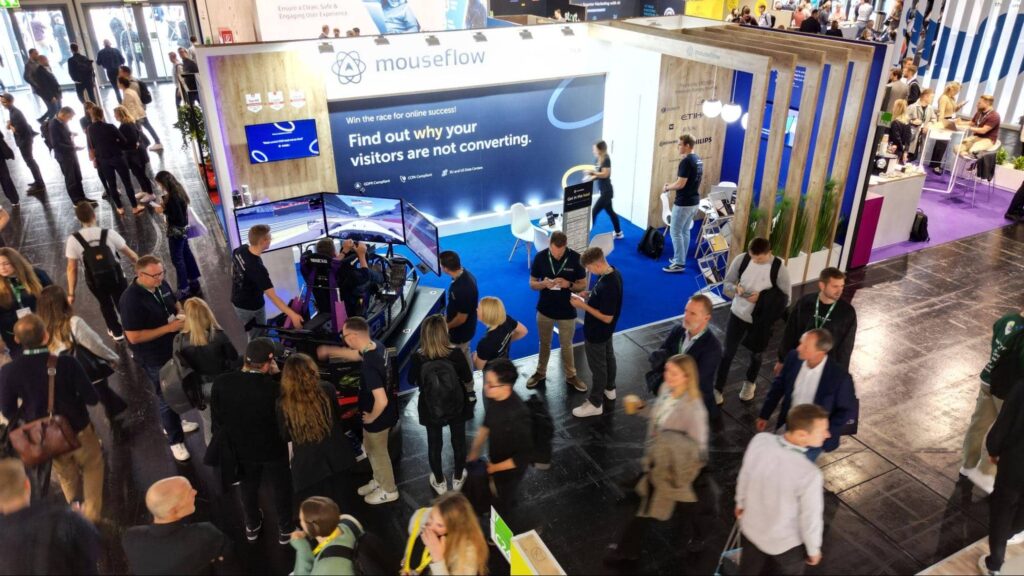
Offering interesting and fun activities at the event booth helps attract more visitors (Mouseflow’s booth at DMEXCO)
What applies to both categories is that event marketing can be very time-consuming. And the marketing part of the event usually doesn’t play as significant a role as the business development and sales part.
12. Conversion Rate Optimization (CRO)
Benefits:
- Even low investment in CRO can lead to significant conversion rate improvements.
Risks:
- Requires a lot of commitment and alignment from the organization and usually some mindset changes as well.
With SaaS businesses having conversions to sign-ups or leads and from leads to paying customers as their primary goals, it makes perfect sense for them to employ conversion rate optimization.
We’ll add landing page optimization to the same bucket, because the principles are the same – hypothesize, run a test to prove or disprove the hypothesis, analyze results, repeat.
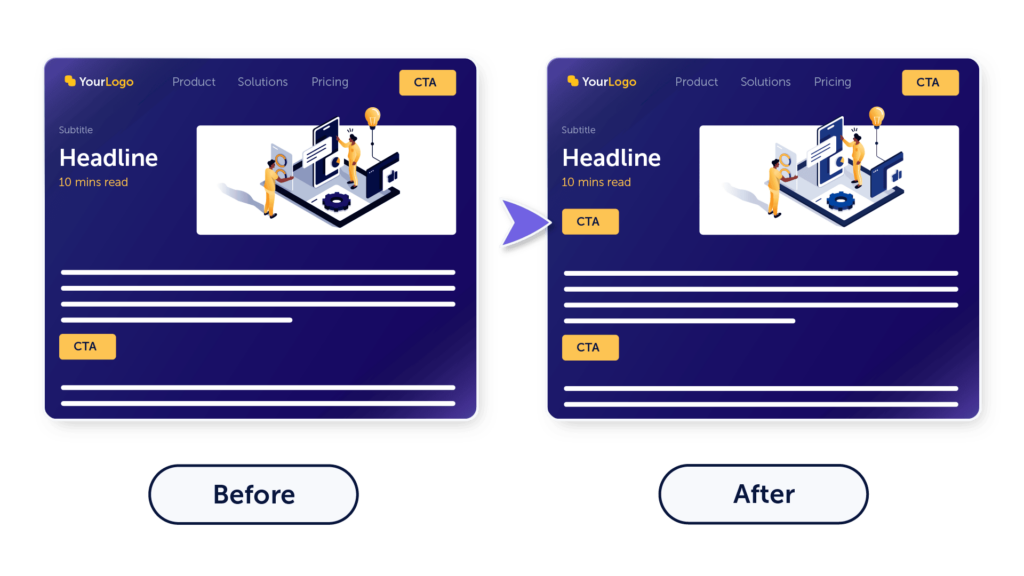
An example of a CRO experiment for SaaS: adding a CTA button in the hero section on the blog.
Conversion rate optimization doesn’t work independently – you still need to get traffic to your website, be it with SEO, Google Ads, event marketing, or some other marketing channel. That’s why CRO often falls under growth marketing together with experimentation on ads and other means of traffic acquisition.
Combined with working traffic acquisition strategies, CRO helps reduce the customer acquisition cost (CAC) by making the customer journey more straightforward and removing friction on the way to signing up or becoming a lead.
For SaaS CRO, the most important aspect is to look at how your efforts influence not only the metrics like conversion rate or bounce rate but also the bottom line – the monthly recurring revenue (MRR).
Check out our blog post on CRO for SaaS for some real-life experiment ideas that brought SaaS businesses plenty of additional revenue.
Also, take a look at this blog post about crafting the right call-to-actions for SaaS.
Bonus: Churn Reduction
Benefits:
- The highest impact on the bottom line among all SaaS marketing strategies.
Risks:
- Doesn’t help with customer acquisition.
For any SaaS, churn reduction is perhaps the most important marketing strategy. And there’s no choosing or not choosing to reduce churn – you either do it or you go out of business.
Improving customer retention (which translates into reducing the customer churn rate) allows SaaS companies to increase customer lifetime value and ensure sustainability. In the long run, that influences the most important SaaS metrics, such as MRR or ARR, like nothing else.
Reducing churn requires a deep understanding of the reasons why customers churn (and why they stay), as well as building relationships with them. A happy customer – that is happy not only with the capabilities of your SaaS, but also with how they are treated and how their problems are resolved – is usually a loyal customer that will stay with your SaaS business for a long time. They might as well become an advocate for it.
What are the tactics you could use to reduce churn?
- Double down on customer success and support. All bigger customers need to have a customer success manager from your B2B SaaS – and be happy with them.
- Improve user experience in the app. Lower the customer effort score (CES), review session replays to find friction points and logic loops – and eliminate them. Check out this blog post on 6 ways of fighting customer churn with UX.
- Improve onboarding to reduce churn in the early stages. That requires understanding what’s wrong with the onboarding in the first place, and to answer this question, you likely need to do some user testing or collect some user feedback.
- Make sure that each problem that customers raise gets addressed timely, especially if they raised it publicly. Lower ticket resolution time and aim for an increase in first-touch resolution support cases.
Parting Thoughts
The SaaS marketing strategies we’ve listed above have been tried and tested by many big (and smaller) names in the industry. They work better in combinations, so when coming up with a SaaS marketing plan, make sure to have at least several of them on the list.
But just like with channels, every expert advises against going for everything at once. If there are too many different strategies on your marketing plan, it becomes impossible to maintain consistency. So, instead of doing something strategic, you risk ending up doing so-called random acts of marketing. A SaaS marketing team of two cannot be doing SEO, socials, ABM, events, and partner marketing at the same time. Or maybe they can, but the effect would be much better if they had more focus.
So, choose where to focus your marketing efforts wisely based on your understanding of your ideal customer persona, the channels they use, and the types of communications they are most likely to respond to in a positive way. Also, make sure that you have a proper product marketing foundation in place – with a resonating messaging and a clear positioning. In combination, these will help you build an effective SaaS marketing strategy that will help your SaaS business grow.
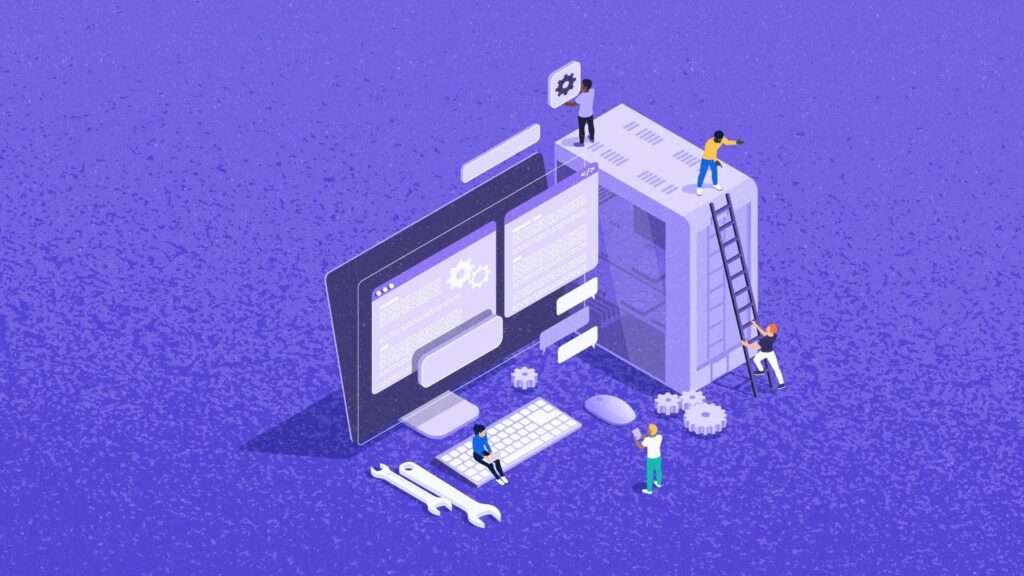
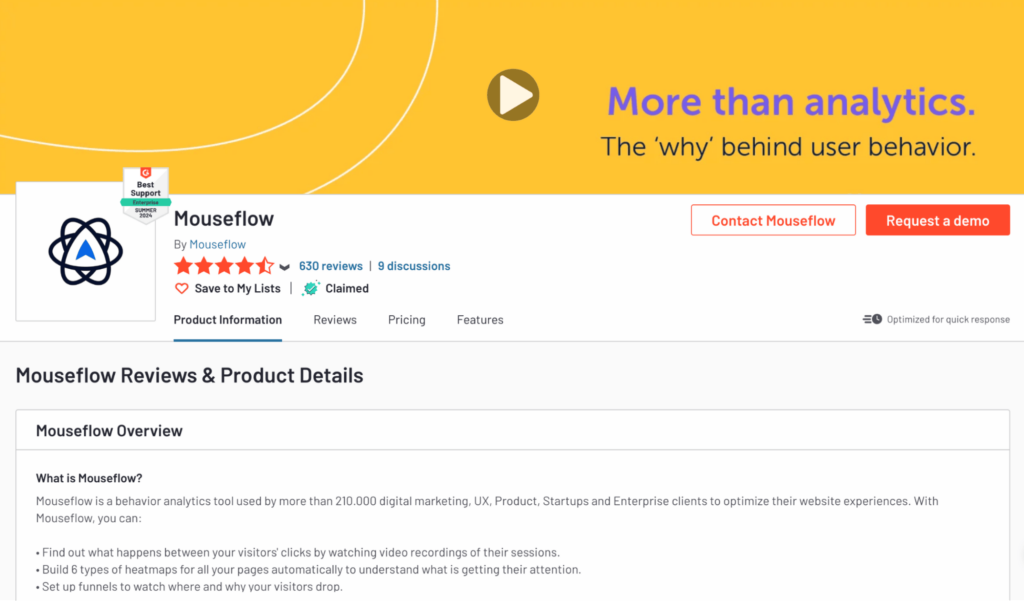
4. Social Ads and Retargeting
Benefits:
Risks:
You can capture demand with SEO and PPC, and you can try to generate demand for your SaaS company by running ads on social media.
For a SaaS company, social media advertising is very different from other digital marketing strategies such as pay-per-click ads (PPC) because the goal here isn’t driving traffic to your website. That has become too expensive lately, and the quality of this traffic is often poor. So, instead of promoting products directly, SaaS companies often focus their paid social media marketing efforts on promoting helpful content such as webinars or reports.
Many SaaS ads you see on LinkedIn (the social media platform for B2B SaaS marketing) are thought leadership ads. If they promote a webinar, it is likely to be happening on the same platform. Usually, social ads are a part of marketing efforts to support a top-of-the-funnel or middle-of-the-funnel marketing campaign.
Unless, of course, we are talking about retargeting. In this case, it’s almost the same as with Google Ads, and often takes place much further down the SaaS marketing funnel.
Some examples of ad creatives Mouseflow used for targeting prospective customers at the consideration stage on LinkedIn.